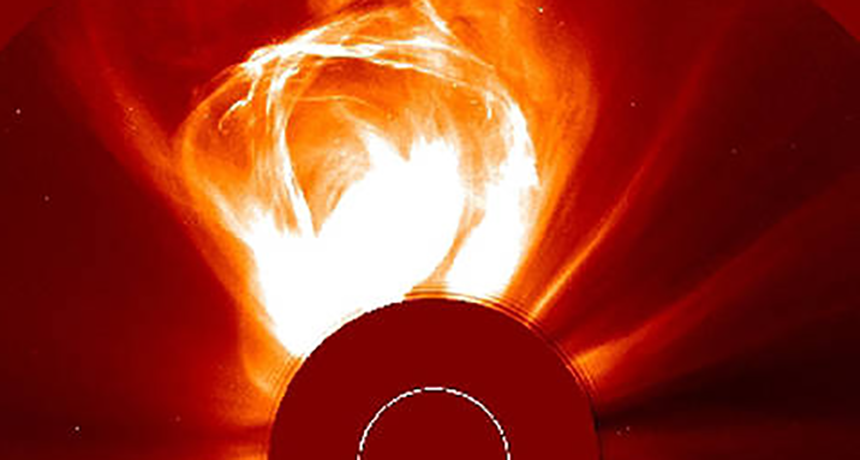atmosphere The envelope of gases surrounding Earth or another planet.
blackout (in energy) The loss of electric power to a broad area, and so named because all of the electric lights in the affected area will blink off when this occurs (unless they have a backup electric generator).
coronal mass ejections The powerful release of huge bubbles of gas threaded with magnetic field lines. These can be spew from the sun over a span of hours. They can accompany solar flares, but usually do not.
electric charge The physical property responsible for electric force; it can be negative or positive.
electricity A flow of charge, usually from the movement of negatively charged particles, called electrons.
field (in physics) A region in space where certain physical effects operate, such as magnetism (created by a magnetic field), gravity (by a gravitational field), mass (by a Higgs field) or electricity (by an electrical field).
hue A color or shade of some color.
ionosphere A layer of Earth’s atmosphere lying around 75 and 1,000 kilometers (47 and 620 miles) above Earth’s surface. It absorbs the sun’s harmful extreme-ultraviolet rays. That energy strips electrons from atoms and molecules, creating a zone full of free-floating ions. The share of ions present, here, affects radio and other signals passing through it.
magnetic field An area of influence created by certain materials, called magnets, or by the movement of electric charges.
particle A minute amount of something.
plasma (in chemistry and physics) A gaseous state of matter in which electrons separate from the atom. A plasma includes both positively and negatively charged particles. (in medicine) The colorless fluid part of blood.
satellite A moon orbiting a planet or a vehicle or other manufactured object that orbits some celestial body in space.
solar wind A flow of charged particles (including atomic nuclei) that have been ejected from the surface of the star, such as our sun. It can permeate the solar system. This is called a stellar wind, when from a star other than the sun.
space weather Conditions on the sun, in the solar wind and within Earth’s upper atmosphere that can affect technologies on Earth and that have the potential to endanger human health. Triggering these weather events are the stream of plasma, or solar wind, emitted by the sun. In addition, there are clouds of material spewed by the sun, known as coronal mass ejections. Together, these can contribute to large magnetic and electrical storms in Earth’s upper atmosphere.
star The basic building block from which galaxies are made. Stars develop when gravity compacts clouds of gas. When they become dense enough to sustain nuclear-fusion reactions, stars will emit light and sometimes other forms of electromagnetic radiation. The sun is our closest star.
sun The star at the center of Earth’s solar system. It’s an average size star about 26,000 light-years from the center of the Milky Way galaxy. Also a term for any sunlike star.
weather Conditions in the atmosphere at a localized place and a particular time. It is usually described in terms of particular features, such as air pressure, humidity, moisture, any precipitation (rain, snow or ice), temperature and wind speed. Weather constitutes the actual conditions that occur at any time and place. It’s different from climate, which is a description of the conditions that tend to occur in some general region during a particular month or season.








